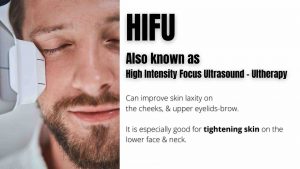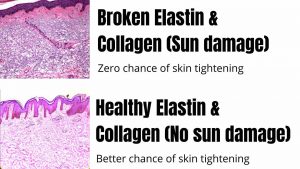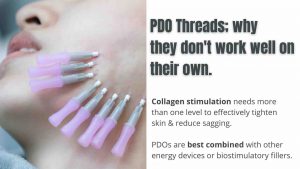At A Glance Ultherapy
- Best Results1-2 sessions
- Treatment RecoveryImmediate
- Procedure Time40 minutes
- Skin SpecialistNurse, therapist
- Duration of ResultsVariable
- AnaestheticNumbing, Gas
- Back to WorkImmediate
- Cost$$
Ultherapy – non surgical skin tightening
Ultherapy – Ulthera is a non-surgical skin tightening & lifting procedure that uses high-intensity ultrasound. This energy heats the deeper layers of the skin producing contraction & production of collagen. This results in skin tightening & lifting of the lower face, jowls, neck & upper lids. This is a no downtime treatment that takes 40 to 60 minutes to perform. This device is also great for contouring the lower face as it destroys unwanted fat.
FactsFacts on Ultherapy Treatments
- Ultherapy is the leading non-surgical face & neck lifting treatment
- Ultherapy delivers ultrasound to provide controlled heating to the deep layers under your skin
- Controlled heating contracts collagen fibers and ligaments
- This treatment can improve skin laxity and wrinkles around the eyes, mouth, & neck, giving a natural non-surgical facelift
- Therapy can be combined with lasers, threads, & hydrating treatments for optimal results
- HIFU or Ultherapy is also used to contour the lower face as it targets jowls & nasolabial folds
- This treatment focuses on the deeper layers of skin & has minimal to no downtime
- Patient sélection is critical for optimal outcomes
Who is an ideal candidate for Ultherapy?
Did you know that Jennifer Aniston maintains her looks with Therapy?
The ideal candidate are those with mild to moderate skin laxity age range late 20s to mid-50s with mild sun damage & a medium to the thick dermal layer.

Where can Ultherapy be used?
Therapy treatments can tighten loose skin on the face, neck, sagging skin under the chin and soften lines and wrinkles on the chest.
Therapy treatments can produce a non-surgical brow lift in patients with mild to moderate skin laxity. Therapy is also a great treatment for adults that are just beginning to see the signs of aging including face, forehead, and neck skin laxity.
In what indicaton do I use Ultherapy most for?
Though HIFU can improve skin laxity by providing skin tightening, my most frequent application of this device is for facial contouring & shaping of the lower face & jawline.
Ultrasound is an awesome device for permanently destroying focal superficial fat, especially in the jowl area.
In summary-
- Reduces jowls permanently
- Requires 2-3 sessions over 3 to 6 months
- Targets nasolabial fat pads & folds
- Reduces under chin fat
- Can be combined with collagen stimulating injectables
*Candidate selection is paramount for results. Read more to understand.
Is Ultherapy painful?
With correct pain relief this procedure is well tolerated. Patients feel warmth on their skin though out the treatment.
For larger areas, we often prescribe Entonox (laughing gas) as this makes the treatments more comfortable.
How long is the Ultherapy procedure?
Ultherapy takes between 30 minutes to 60 minutes depending on the areas treated. Some patients may only need a small area treated, whilst others will benefit from an Ultherapy neck and face-lift in the same session.


View our Treatment Gallery
How is Ultherapy performed?
The procedure is performed using an ultrasound to first determine the patient’s facial anatomy. Once visualized on the screen, the ultrasound is precisely delivered to the layers of concern.
How many Ultherapy sessions will I require?
Between 1-3 depending on the concerns.
- General skin tightening 1 session
- Focal reduction of jowls & NL folds 1-3
- Under chin fat 2-3 sessions
When will I see the results from Ultherapy?
Full results are visible after 3-6 months. Most patients require only one procedure. Treatment plans are individualized depending on each patient’s skin laxity and treatment goals.
Most of my patients will benefit from combination therapy of Ultherapy & procedures such as laser resurfacing, thread lifts & hydrating treatments. Remember it is the balance of skin texture, tone and volume that gives the best and most natural results. In Brisbane, the majority of my patients will also have some degree of sun damage and pigmentation, and hence lasers such as Pico or Fraxel in combination with Ultherapy will deliver optimal outcomes.
Volume replacement can only be achieved with hydrating treatments or autologous fat transfer.
Overly simplified. Skin tightening (non-surgical) is generally unpredictable, with many different players ranging from home DIY #microcurrent to more powerful devices- HIFU, RF Facetite & many RF microneedling devices
.
👉Lasers can work in the upper, mid & lower dermis. Ablative over non-ablative
.
🍌Peels do the same, however for good results you do need at the very least a medium depth chemical peel
.
💉Collagen stimulating fillers? Love them, with PLLA, CaOh apatite & a new hybrid HA filler being released in Oz next month
.
🪡Threads? We have been using PDO monos to good effect, especially if combined with other modalities
.
👍🏻How I view non-surgical skin tightening: It’s an arcade game. You start off with a dozen or so tokens. Choose your game wisely (not just from a $$ point of view, but sooner or later you will run out of modalities that DO work). I normally start my patients on milder treatments, increasing the intensity over time
.
😎Dr Davin Lim
Dermatologist
Brisbane🇦🇺
#skin #dermatology #dermatologist #nuera #RF #RFmicroneedling #RFM #facetite #HIFU #Ultherapy #skintightening #fractionallasaer #laserresurfacing #co2lasers #drdavinlim
Lighting could be better, however in the after photos the better light reflex & luminosity reflects the better skin quality following treatment
.
👉The Procedure: Jessner TCA peel & low density CO2 in key vectors in addition to 60 PDO threads in vectors, RF at 3.5 mm. One session only. Predicable non-surgical skin tightening follows a complex algorithm based on clinical features, genetics, ethnicity, goals, equipment, & more
.
👍🏻The logic: Stimulation of all layers from the mid to superficial dermis (peel), deeper dermis (low density but high power CO2), hypodermis (RFM) & hypodermis & fibroseptal network (PDO threads)
.
⏭Next stage: dermal fillers to further improve the outcomes
.
🙄Suitable patients: mild to moderate laxity (leaning towards mildish). For lighter types, I prefer lasers or medium to deep peels, for darker skin types I use RF devices (RFM, NuEra, Pelleve) & HIFU
.
🎬Action: For an opinion on threads & skin tightening book a consult with Katie or Alison at Cutis Dermatology
.
😎Davin Lim
Dermatologist
Brisbane🇦🇺
AU
.
#lskintightening #HIFU #pdothreads #threadlifting #skinlaxity #brisbanedermatologist #dermatology #skinscience #facelifting #nonsurgicalfacelift #threadlift #mintpdo #mintthreads #pdothreadlifting
Yeah, lighting not quite perfect, by you get the picture😁
.
👍🏻☄️Device: Tixel, B+A courtesy of Jean at Cutis Dermatology
.
🧐What is it?: short contact heating via titanium pins
.
👉How does it work?: Collagen stimulation via heat
.
👁What is it really good at?: Eyes
.
👍🏻What else can it do?: Lots. Improve skin quality, treat early acne scars, stretch marks & even aid in transepidermal delivery of Botox & other ‘ingredients’
.
🙄How many sessions?: 2-4
.
📚More at NSS in 3 weeks time. The company is running a masterclass, my team & I will present our settings & indications. See ya all there💯
.
😎Davin Lim
Dermatologist
Cutis Dermatology🇦🇺
.
#tixel #tixeleyes #tixeltreatment #eyerejuvenation #eyes #wrinkletreatment #eyewrinkles
#tixelrejuvenation
What is the science behind Ultherapy?
Ultherapy can target three different depths: the dermis (deeper skin), fat + connective tissue (fibro-septal network) as well as the layer just above the muscle known as the SMAS (Superficial Musculoaponeurotic System).

The Superficial Musculoaponeurotic System (SMAS) is located below the fat and consists of a fibrous envelope that surrounds the muscles of the face. The SMAS is made up of collagen, elastic fibers, muscle fibers and fat cells.
Ultherapy produces High Intensity Focus Ultrasound or HIFU. This energy precisely heats the tissue to 67 degrees centigrade, which is the optimal temperature for contraction and denaturation of collagen. Other non-invasive devices like, Thermage, are radiofrequency devices which only heat the tissues to 40-50 degrees, which is suboptimal for the stimulation and contraction of collagen.
The results from an Ultherapy treatment work in a two-step process. The first stage is the contraction and denaturing of collagen, which causes an immediate tissue tightening, and resultant lift.
The second stage occurs over time while the body’s healing response builds new collagen (neocollagenesis). New collagen production is generated over 2-3 months and often continues for 6 months after the treatment.

Can Ultherapy be combined with other treatments?
Absolutely. In fact, due to the extreme UV exposure in Brisbane, over half of my Ultherapy patients undertake laser at the same time. Remember, Ultherapy treats under the skin’s surface to tighten and lift. Lasers treat the upper layers of the skin to improve texture, namely pigmentation, open pores, lines and wrinkles.
Some of my favourite combinations include –
- Ultherapy & Fraxel 1927- best for skin laxity and moderate sun damage
- Ultherapy and CO2- best of skin laxity, wrinkles and sun damage
- Ultherapy & BBL or IPL- best for skin laxity and pigmentation
- Ultherapy and Pico laser resurfacing- best for skin laxity and pigmentation in Ethnic skin types

Threads must be combined with other treatments to be effective. The combination of HIFU & threads are synergistic.

Can all skin types and races be treated with Ultherapy?
Yes. Ultherapy is colour blind as it is not a laser. This means all skin types can be treated- from Caucasian skin to Ethnic and Asian skin types.
What are the possible side effects following Ultherapy?
Temporary side effects of Ultherapy are flushed skin, mild swelling, tingling and tenderness. This subsides over 24-36 hours at most. Mild bruising and numbness are rare side effects.
I do not use this device in patients of low facial fat & or a thin dermis. This is because contraction of collagen & the fibro-fat layer can result in a more ‘volume depleted’ & gaunt look. For this subgroup one has to be very careful with non-surgical energy devices. Volume correction is advocated with this phenotype.
Can HIFU cause facial fat loss?
Absolutely, that is why we use it in the first place. Ultrasound energy is a very effective & efficient way of permanently reducing fat in key areas such as the jowl & nasolabial fat pads. This is our most frequently used indication of HIFU.
Patient selection, depth of treatment, pulse count & treatment areas are all factors we consider prior to treatment. Fat loss is not a side effect of this treatment, used as indicated this an expected & predicable outcome.
How to maximise and maintain treatment results?
To maximize the positive inflammatory response created by Ultherapy, patients to avoid anti-inflammatory medications such as Brufen and, Naproxen for 2 weeks following the procedure. This inflammatory response is beneficial to allow your body to stimulate collagen fiber formation and modeling.
Collagen stimulating hydrating treatments & monofilament MINT threads can be employed prior to, or after Ultherapy for maximal collagen stimulation.

How much does Ultherapy cost?
Cost will depend on the areas treated and if other lasers are used with Ultherapy. Treatments start from $ 990.
How do I make a booking for Ultherapy treatment?
Patient selection is critical for the very best outcomes with this device. This means a detailed examination is required to see if you are a good candidate for non-surgical face and neck lifting.
For Sydney patients, book an appointment with Louise at Dr Van Park’s clinic.
What is the difference between Ultherapy & Ultraformer?
Ultherapy is a first generation HIFU device (which is still very good). It uses ultrasound for imaging. Ultraformer Series 3 is the third generation device, whilst the newest 4th gen device is the Ultraformer MPT.
*In Brisbane we still use Ultherapy, however the Sydney clinic employs the latest Ultraformer MPT.
What is Ultraformer MPT?
Ultraformer MPT is the very latest HIFU that replaces the Ultraformer III (3). It is over a decade newer than Ultherapy.
MPT stands for micro pulse technology, essentially delivering micro coagulation zones that are closely packed together. It is 2.5 times faster than the previous generation & is a more comfortable treatment as compared to other HIFU devices.
We have this technology in the Sydney clinic.
Davin’s viewpoint on Ultherapy
Remember it is the combination of balanced texture, tone and volume that gives the most beautiful and natural results. Ultherapy provides improved skin tone to lift saggy skin, heavy eyelids, and jowls. The best results following Ultherapy is dependent on 2 main factors- patient selection and treatment methods.
Firstly, the ideal patient should have mild to moderate laxity in areas such as the lower face, eyelids, and/or neck areas. For patients with marked laxity- my treatment of choice is a mini-s –face lift, as Ultherapy limitations on what it can achieve. The most important factor is how this procedure is performed. This determines the results.

In Brisbane, with significant background sun damage, over half my Ultherapy cases are performed with laser therapy during the same procedure. Remember, Ultherapy tightens the skin, whilst lasers treat the palate of the skin, removing sun damage and fine wrinkles.
If you are volume depleted or if you have a thin dermal layer, this treatment is not for you. You will achieve better results with collagen stimulating injectables, hydrating treatments, fat transfer & or hydration treatment thread placement.

The big debate (at least in previous years), is whether this device causes fat loss. The resounding answer is ABSOLUTELY. This is the most frequent indication as to why we use this devices in the first place- namely to selectively & precisely destroy unwanted superficial fat in key area such as the jowls & nasolabial folds. For many years Merz, the company that makes Ultherapy has denied fat atrophy, however dermatologists & plastic surgeons have been using ultrasound off label to permanently destroy fat for over a decade. Goto pubmed.com (medical search engine), type in HIFU or Ultrasound and fat atrophy & you will see the recent reports of fat destruction with focused ultrasound.
Make no mistake, this is a very powerful device, in fact it is THE device of choice for fat destruction as ultrasound is far more effective as this job as compared to RF microneedling, lasers & monopolar RF devices. Patient selection (as reinforced throughout this page) is paramount.
What’s my favourite combination/s with Ultherapy?
My goto combos are-
- Lower face treatment. These injections reduce the pull of muscles of the lower face, in turn amplifying the results of HIFU. Injections can be performed on the day of treatment & take 5 minutes to perform. This typically last 4 to 5 months.
- Collagen stimulating injectables. Biostimulatory injectables are designed to provide additional collagen in the deeper dermis. This amplifies the results of HIFU- Ultherapy as it reduces skin laxity & provide a non-surgical face lifting option in select patients. The type of injectable depends on factors such as lower face volume, skin quality (measure of dermal collagen), skin hydration & turgor. Dr Van Park & I employ injectables that include hybrid complex hyaluronic acids, Polymer Injectable, CAH, polycaprolactone & polynucleotides. We tailor dilution ratios based upon clinical features. Biostimulatory injectables are designed to reduce age related collagen depletion. They are performed 2-4 times annually, depending on the patient’s age & quality of the skin.


